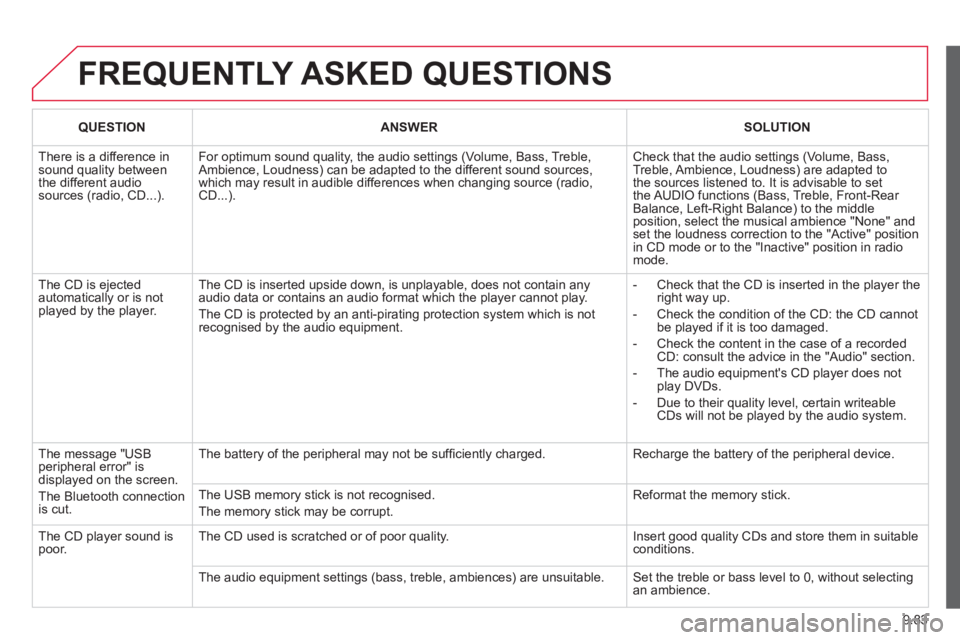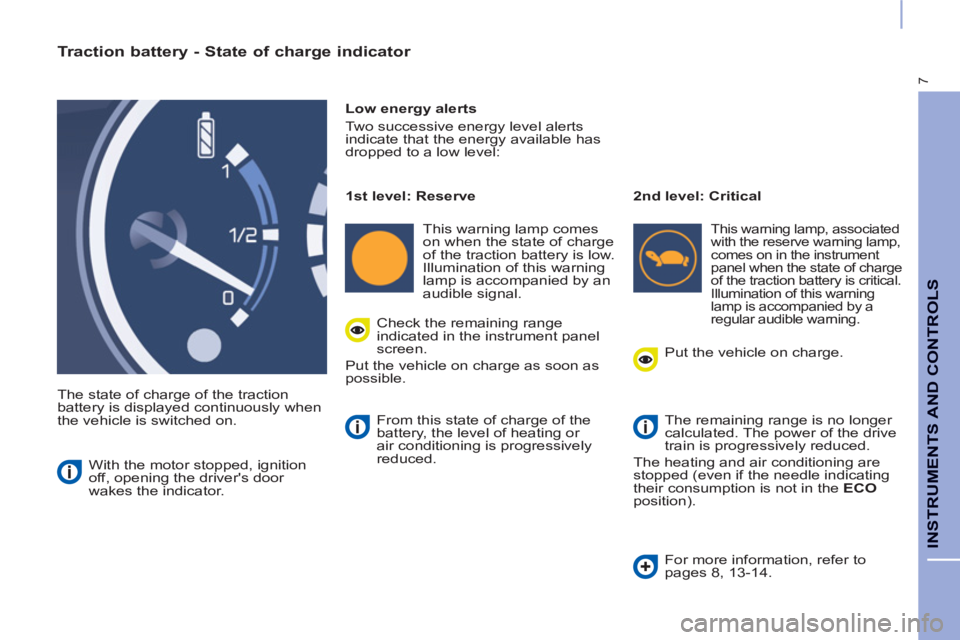Page 225 of 272

9.83
FREQUENTLY ASKED QUESTIONS
QUESTIONANSWERSOLUTION
There is a difference in sound quality betweenthe different audiosources (radio, CD...).
For optimum sound quality, the audio settings (Volume, Bass, Treble, Ambience, Loudness) can be adapted to the different sound sources,which may result in audible differences when changing source (radio,CD...).
Check that the audio settings (Volume, Bass, Treble, Ambience, Loudness) are adapted tothe sources listened to. It is advisable to setthe AUDIO functions (Bass, Treble, Front-Rear Balance, Left-Right Balance) to the middle position, select the musical ambience "None" and set the loudness correction to the "Active" position in CD mode or to the "Inactive" position in radio mode.
The CD is ejected automatically or is not played by the player.
The CD is inserted upside down, is unplayable, does not contain any audio data or contains an audio format which the player cannot play.
The CD is protected by an anti-pirating protection system which is not recognised by the audio equipment.
- Check that the CD is inserted in the player the right way up.
- Check the condition of the CD: the CD cannot be played if it is too damaged.
- Check the content in the case of a recordedCD: consult the advice in the "Audio" section.
- The audio equipment's CD player does notplay DVDs.
- Due to their quality level, certain writeableCDs will not be played by the audio system.
The message "USB peripheral error" isdisplayed on the screen.
The Bluetooth connectionis cut.
The battery of the peripheral may not be suffi ciently charged.
Recharge the battery of the peripheral device.
The USB memory stick is not recognised.
The memory stick may be corrupt.
Reformat the memory stick.
The CD player sound ispoor.The CD used is scratched or of poor quality.
Insert good quality CDs and store them in suitable conditions.
The audio equipment settings (bass, treble, ambiences) are unsuitable. Set the treble or bass level to 0, without selectingan ambience.
Page 226 of 272

9.84
QUESTIONANSWERSOLUTION
The stored stations donot function (no sound, 87.5 Mhz is displayed...).
An incorrect waveband is selected.
Press the BAND AST button to return to the waveband (AM, FM1, FM2, FMAST) on which thestations are stored.
The traffi c announcement(TA) is displayed. I donot receive any traffi c information.
The radio station is not part of the regional traffi c information network.
Tune to a radio station which broadcasts traffi c information.
The quality of receptionof the radio station listened to graduallydeteriorates or the stored stations do not function(no sound, 87.5 Mhz is displayed...).
The vehicle is too far from the transmitter used by the station listenedto or there is no transmitter in the geographical area through which the vehicle is travelling.
Activate the RDS function to enable the system to check whether there is a more powerful transmitter in the geographical area.
The environment (hills, buildings, tunnels, basement car parks...) block reception, including in RDS mode. This phenomenon is normal and does not indicate a failure of the audio equipment.
The aerial is absent or has been damaged (for example when goingthrough a car wash or into an underground car park).
Have the aerial checked by a CITROËN dealer.
Sound cut-outs of 1 to2 seconds in radio mode.During this brief sound cut-out, the RDS searches for any frequency permitting better reception of the station.
Deactivate the RDS function if the phenomenon is too frequent and always on the same route.
With the engine off, the audio equipment switches off after a few minutes of use.
When the engine is switched off, the audio equipment operating timedepends on the battery charge.
The switch-off is normal: the audio equipment switches to economy mode and switches off to prevent discharging of the vehicle's battery.
Start the vehicle's engine to increase the batterycharge.
The message "the audio system is overheated" appears on the display.
In order to protect the installation if the surrounding temperature is toohigh, the audio equipment switches to an automatic thermal protectionmode leading to a reduction of the volume or stopping of the playing of the CD.
Switch the audio system off for a few minutes toallow the system to cool.
Page 229 of 272
143
Instruments and controls
VISUAL SEARCH
10
Heating, ventilation
- heating 59
- air conditioning 60
Digital air conditioning 61-62
Demisting/defrosting 63-64
Rear view mirror 79
Toll cards, car park tickets 79
Controls
- central locking 26
- load space locking 26
- electric windows 80
- hazard warning lamps 81
Electronic gearbox 40-42
Cab fi ttings 70-71
- glove box,
- overhead storage,
- console,
- sun visor,
- bottle holder,
- bag holder,
- storage compartments under
seats,
- storage compartment.
Screens, display 27, Section 9
Setting the time
in the screen Section 9
Dashboard, passenger
compartment fuses 128-130
Opening the bonnet 106
On-board technology Section 9
- eMyWay
- Audio system
Emergency or
assistance call Section 9
"Grip control" 86-87
Courtesy lamps 72, 125
Page 240 of 272
2
Presentation3
Indicators6
Warning and indicator lamps9
Display screens 10
Starting procedure 11
Eco-driving 12
Eco-comfort 13
Manual air conditioning and heating 14
Charging the traction battery 15
Control unit 17
Normal charging procedure 19
Fast charging procedure 22
Other information 23
Ancillaries battery 25
Fuses 28
Servicing 29
Towing the vehicle 30
Motor and traction battery 31
Identifi cation markings 32
CONTENTS
Page 242 of 272
4
Instruments and controls
Instrument panel
p.5 Drive selector
p.11
Display screens
p.10
Page 245 of 272

7
INSTRUMENTS AND CONTROLS
Traction battery - State of charge indicator
The state of charge of the traction
battery is displayed continuously when
the vehicle is switched on.
Low energy alerts
Two successive energy level alerts
indicate that the energy available has
dropped to a low level:
With the motor stopped, ignition
off, opening the driver's door
wakes the indicator.
1st level: Reserve
This warning lamp comes
on when the state of charge
of the traction battery is low.
Illumination of this warning
lamp is accompanied by an
audible signal.
2nd level: Critical
This warning lamp, associated
with the reserve warning lamp,
comes on in the instrument
panel when the state of charge
of the traction battery is critical.
Illumination of this warning
lamp is accompanied by a
regular audible warning.
Check the remaining range
indicated in the instrument panel
screen.
Put the vehicle on charge as soon as
possible. Put the vehicle on charge.
The remaining range is no longer
calculated. The power of the drive
train is progressively reduced.
The heating and air conditioning are
stopped (even if the needle indicating
their consumption is not in the ECO
position). From this state of charge of the
battery, the level of heating or
air conditioning is progressively
reduced.
For more information, refer to
pages 8, 13-14.
Page 248 of 272
10
DISPLAY SCREENS
Screen (depending on
equipment level)
Each press of the button on the end
of the windscreen wiper stalk displays
successively the different trip computer
information, depending on the type of
screen.
Setting the units
Range
It displays:
- the estimated range remaining,
- the additional range available
by using the ECO
mode on the
heating and air conditioning control
panel,
- the additional range after stopping
the heating and air conditioning.
They display:
- a trip distance recorder (choice of
trip 1 or 2),
- the average energy consumption from
the battery (over 62 miles (100 km)),
- the speed.
Trips (1 and 2)
This screen displays an estimate of the
number of miles or kilometres driving
range before the battery has to be
charged.
Instrument panel
Page 249 of 272

11
Starting the vehicle
- To start the vehicle, the
drive selector must be in
position P
,
- press the brake pedal,
- torn the ignition key in the
switch.
STARTING PROCEDURE
This indicator lamp comes on
when the vehicle is ready to drive.
- Press the brake pedal,
- select R
or D
,
- release the brake pedal
and press the accelerator
pedal to move off. The selection appears in the current
energy consumption screen in the
instrument panel.
Drive selector
If the drive selector is not in
position P
and/or if the brake pedal is
not pressed, The vehicle will not start.
Repeat the procedure for starting the
vehicle.
The selection of position D
or R
on
the drive selector determines the drive
direction. It is preferable to be at a
full stop before changing the drive
direction.
P
(Park). Parking. Move the
selector to position P
, there is
an audible signal.
N
(Neutral). Move the
selector to position N
, there is
an audible signal.
Do not select this position, even
momentarily, when the vehicle is
moving.
The vehicle is free-wheeling. Select D
to return to forward drive.
D
(Drive). Forward drive.
Move the selector to
position D
, there is an audible
signal.
It is recommended that you keep
your foot on the brake pedal when
selecting positions R
or D
.
R
(Reverse). Reverse
drive. Move the selector to
position R
, there is an audible
signal.
Only engage reverse when the
vehicle is immobilised.
When moving from position R
to
position P
, N
is displayed momentarily
in the instrument panel.
There is an audible signal when
changing drive position with the
selector.
The audible signal is deactivated if the
user has chosen to inhibit operation of
the "Rear parking sensors".
The driver must be particularly
vigilant when driving the electric
vehicle as it makes very little noise
when moving.
Ready
Parking the vehicle
When leaving the vehicle, it is strongly
recommended that you apply the
parking brake, place the drive selector
in position P
then switch off the
ignition.
There is an audible signal on opening
the driver's door if:
-
the ignition is still on (" Ready
" lamp on),
- the vehicle has not been correctly
immobilised (drive selector not in
position P
).
An alert message is displayed in the screen.